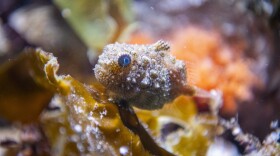In May of 2015, Jason Love and Luke Tufts – two friends who met at the University of Washington – went fossil hunting around the Hell Creek Formation in Northeastern Montana, a region known for its fossil sites.
On their last day, the two went out on government land to cover some more ground before heading home.
“Fifteen minutes into it Jason walked onto to a big boulder with some bones in it,” Tufts said.
Those bones ended up being the remains of a Tyrannosaurus rex. Scientists at the museum are now in the process of revealing the fossilized skull of the T. rex. It’s been encased in rock for more than 66 million years.
“I’m not an employee of the Burke Museum nor do I have any training in paleontology,” Love said.
They did take a paleontology class when they were undergrads together. Love calls it “Dinosaurs 100.”
“We learned a lot,” he said. “But the tests were very easy.”
Now, the two enjoy searching for fossils in their free time.
At the museum, what is normally a behind the scenes job, is now on display for the public. Viewers can see experts using small hand tools to carefully chip away at rock that’s covering the skull, which has been named the “Tufts-Love Rex” after Luke and Jason.
Love said one of the benefits of having this skull on display is that it gets children interested in science.
“They’re here in the museum learning about dinosaurs. Maybe they’ll do that, take [the experience] back to school and learn to study science,” he said.
The fossil is one of a handful ever discovered and the first on display in Washington.
The restoration process will be on display for the public through Labor Day weekend.
The final product will eventually be on display in the new Burke Museum, due to open in 2019.






